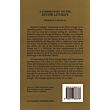A Commentary on the Divine Liturgy
Nicholas Cabasilas
Translated by J. M. Husey and P. A. McNulty
With an Introduction by R. M. French
Translated by J. M. Husey and P. A. McNulty
With an Introduction by R. M. French
Publication Data: Crestwood, NY: St Vladimir’s Seminary Press, 1998
Format: softcover
Number of Pages: xii + 120
Dimensions (l × w × h): 21.5 cm × 13.6 cm × 0.9 cm
ISBN: 0‒913836‒37‒0
Nicholas Cabasilas
Translated by J. M. Husey and P. A. McNulty
With an Introduction by R. M. French
“The essential act in the celebration of the holy mysteries is the transformation of the elements into the Divine Body and Blood; its aim is the sanctification of the faithful, who through these mysteries receive the remission of their sins and the inheritance of the kingdom of heaven. As a preparation for, and contribution to, this act and this purpose we have prayers, psalms, and readings from Holy Scripture; in short, all the sacred acts and forms which are said and done before and after the consecration of the elements. While it is true that God freely gives us all holy things and that we bring him nothing, but that they are absolute graces, he does nevertheless require that we should be fit to receive and preserve them; and he would not permit those who were not so disposed to be thus sanctified.”
—“I INTRODUCTION AND PROTHESIS”
CONTENTS
Foreword
Bibliographical Note (1978)
Introduction
Commentary on the Divine Liturgy
I Introduction and the Prothesis
1. The general significance of the sacrifice
2. Why the offerings are not placed upon the altar at once
3. The oblations are dedicated to God as first fruits of human life
4. Why should we offer the first fruits of human life?
5. Why all the beard is not offered, but only a part of it
6. Why the priest marks the bread with the symbols of Christ’s Passion
7. The commemoration of the Lord
8. Ceremonies performed with the bread
9. Why did the Lord command us to do this in memory of him?
10. The words of the offering after the commemoration. The offering of the gifts is both in thanksgiving and in supplication
11. The reason why the gifts are covered, and the words which are said
II The Liturgy of the Catechumens
12. The opening doxology
13. The meaning of the prayer for God’s mercy after every petition
14. The commendation
15. Of the antiphonary chants and their accompanying prayers
16. A summary of the general significance of the sacrifice
17. The meaning of the first antiphon
18. The meaning of the singing of the prophecies at the beginning of the liturgy
19. The meaning of the third antiphon
20. The showing of the Gospel, and the Trisagion
21. The prayer which accompanies the Trisagion, and the sacred acclamations
22. The readings from Scripture, their order and meaning
23. The prayers which follow the Gospel
III The Liturgy of the Faithful (1)
24. The bearing of the offerings to the altar
25. The prayers which follow the transference of the offerings, and the exhortations of the priest to the congregation
26. The confession of faith, the exhortations of the priest to the faithful, and their responses
27. The consecration of the offerings, and the thanksgiving which precedes it
28. The origin of our faith concerning these mysteries
29. The criticisms certain Latins made of us, and a refutation of these
30. That in the Latin Church the consecration is performed in the same way as by us
31. Why, during the consecration, the priest invokes not the Son but the Father
32. Of the sacrifice itself, and what is sacrificed
IV The Liturgy of the Faithful (2)
33. The prayers after the sacrifice. Why the priest commemorates the saints and especially the all-holy Virgin here
34. What the priest asks for himself and for the holy offerings, and the intentions for which he asks the faithful to pray
35. The Lord’s Prayer and the bowing of the head; the accompanying prayer and doxology
36. The proclamation of the priest to the people when he elevates the holy offerings, and their reply
37. The meaning of the pouring of warm water into the wine
38. How the holy mysteries represent the Church
39. Of the summoning of the faithful to Communion, and their acclamation of the Sacred Gifts when they are shown to them
40. The priest’s prayer for the faithful who have communicated
41. Thanksgiving and doxology
V A Theological Parenthesis
42. Whether the faithful departed are sanctified by the holy offerings as the living are
43. That sanctification is wrought chiefly in the soul of the communicant
44. The mediation of Christ
45. That sanctification works more perfectly for the departed
46. Why the holy offerings are always acceptable to God
47. The measure in which the holy offerings are accepted
48. Why we venerate and honour the saints by these gifts
49. Against those who maintain that the commemoration of the saints in the liturgy is a prayer to God on their behalf
50. How many times the commemoration of the saints takes place, and the difference between these commemorations
51. Why the priest calls the sacrifice a “reasonable service”
52. Why the sacrifice is called the Eucharist
IV Thanksgiving and Closing Prayers
53. Thanksgiving after the communion, and the closing prayers
Format: softcover
Number of Pages: xii + 120
Dimensions (l × w × h): 21.5 cm × 13.6 cm × 0.9 cm
ISBN: 0‒913836‒37‒0
Nicholas Cabasilas
Translated by J. M. Husey and P. A. McNulty
With an Introduction by R. M. French
“The essential act in the celebration of the holy mysteries is the transformation of the elements into the Divine Body and Blood; its aim is the sanctification of the faithful, who through these mysteries receive the remission of their sins and the inheritance of the kingdom of heaven. As a preparation for, and contribution to, this act and this purpose we have prayers, psalms, and readings from Holy Scripture; in short, all the sacred acts and forms which are said and done before and after the consecration of the elements. While it is true that God freely gives us all holy things and that we bring him nothing, but that they are absolute graces, he does nevertheless require that we should be fit to receive and preserve them; and he would not permit those who were not so disposed to be thus sanctified.”
—“I INTRODUCTION AND PROTHESIS”
CONTENTS
Foreword
Bibliographical Note (1978)
Introduction
Commentary on the Divine Liturgy
I Introduction and the Prothesis
1. The general significance of the sacrifice
2. Why the offerings are not placed upon the altar at once
3. The oblations are dedicated to God as first fruits of human life
4. Why should we offer the first fruits of human life?
5. Why all the beard is not offered, but only a part of it
6. Why the priest marks the bread with the symbols of Christ’s Passion
7. The commemoration of the Lord
8. Ceremonies performed with the bread
9. Why did the Lord command us to do this in memory of him?
10. The words of the offering after the commemoration. The offering of the gifts is both in thanksgiving and in supplication
11. The reason why the gifts are covered, and the words which are said
II The Liturgy of the Catechumens
12. The opening doxology
13. The meaning of the prayer for God’s mercy after every petition
14. The commendation
15. Of the antiphonary chants and their accompanying prayers
16. A summary of the general significance of the sacrifice
17. The meaning of the first antiphon
18. The meaning of the singing of the prophecies at the beginning of the liturgy
19. The meaning of the third antiphon
20. The showing of the Gospel, and the Trisagion
21. The prayer which accompanies the Trisagion, and the sacred acclamations
22. The readings from Scripture, their order and meaning
23. The prayers which follow the Gospel
III The Liturgy of the Faithful (1)
24. The bearing of the offerings to the altar
25. The prayers which follow the transference of the offerings, and the exhortations of the priest to the congregation
26. The confession of faith, the exhortations of the priest to the faithful, and their responses
27. The consecration of the offerings, and the thanksgiving which precedes it
28. The origin of our faith concerning these mysteries
29. The criticisms certain Latins made of us, and a refutation of these
30. That in the Latin Church the consecration is performed in the same way as by us
31. Why, during the consecration, the priest invokes not the Son but the Father
32. Of the sacrifice itself, and what is sacrificed
IV The Liturgy of the Faithful (2)
33. The prayers after the sacrifice. Why the priest commemorates the saints and especially the all-holy Virgin here
34. What the priest asks for himself and for the holy offerings, and the intentions for which he asks the faithful to pray
35. The Lord’s Prayer and the bowing of the head; the accompanying prayer and doxology
36. The proclamation of the priest to the people when he elevates the holy offerings, and their reply
37. The meaning of the pouring of warm water into the wine
38. How the holy mysteries represent the Church
39. Of the summoning of the faithful to Communion, and their acclamation of the Sacred Gifts when they are shown to them
40. The priest’s prayer for the faithful who have communicated
41. Thanksgiving and doxology
V A Theological Parenthesis
42. Whether the faithful departed are sanctified by the holy offerings as the living are
43. That sanctification is wrought chiefly in the soul of the communicant
44. The mediation of Christ
45. That sanctification works more perfectly for the departed
46. Why the holy offerings are always acceptable to God
47. The measure in which the holy offerings are accepted
48. Why we venerate and honour the saints by these gifts
49. Against those who maintain that the commemoration of the saints in the liturgy is a prayer to God on their behalf
50. How many times the commemoration of the saints takes place, and the difference between these commemorations
51. Why the priest calls the sacrifice a “reasonable service”
52. Why the sacrifice is called the Eucharist
IV Thanksgiving and Closing Prayers
53. Thanksgiving after the communion, and the closing prayers
Write Your Own Review






